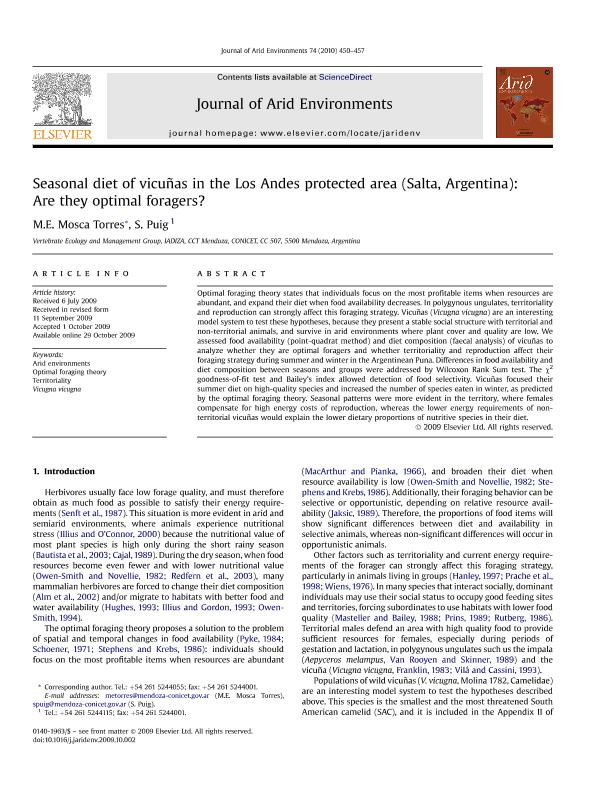Artículo
Seasonal diet of vicuñas in the Los Andes protected area (Salta, Argentina): Are they optimal foragers?
Fecha de publicación:
04/2010
Editorial:
Academic Press Ltd - Elsevier Science Ltd
Revista:
Journal of Arid Environments
ISSN:
0140-1963
Idioma:
Inglés
Tipo de recurso:
Artículo publicado
Clasificación temática:
Resumen
Optimal foraging theory states that individuals focus on the most profitable items when resources are abundant, and expand their diet when food availability decreases. In polygynous ungulates, territoriality and reproduction can strongly affect this foraging strategy. Vicuñas (Vicugna vicugna) are an interesting model system to test these hypotheses, because they present a stable social structure with territorial and non-territorial animals, and survive in arid environments where plant cover and quality are low. We assessed food availability (point-quadrat method) and diet composition (faecal analysis) of vicuñas to analyze whether they are optimal foragers and whether territoriality and reproduction affect their foraging strategy during summer and winter in the Argentinean Puna. Differences in food availability and diet composition between seasons and groups were addressed by Wilcoxon Rank Sum test. The χ2 goodness-of-fit test and Bailey's index allowed detection of food selectivity. Vicuñas focused their summer diet on high-quality species and increased the number of species eaten in winter, as predicted by the optimal foraging theory. Seasonal patterns were more evident in the territory, where females compensate for high energy costs of reproduction, whereas the lower energy requirements of non-territorial vicuñas would explain the lower dietary proportions of nutritive species in their diet.
Palabras clave:
Arid Environments
,
Optimal Foraging Theory
,
Territoriality
,
Vicugna Vicugna
Archivos asociados
Licencia
Identificadores
Colecciones
Articulos(IADIZA)
Articulos de INST. ARG DE INVEST. DE LAS ZONAS ARIDAS
Articulos de INST. ARG DE INVEST. DE LAS ZONAS ARIDAS
Citación
Mosca Torres, Maria Eugenia; Puig, Silvia; Seasonal diet of vicuñas in the Los Andes protected area (Salta, Argentina): Are they optimal foragers?; Academic Press Ltd - Elsevier Science Ltd; Journal of Arid Environments; 74; 4; 4-2010; 450-457
Compartir
Altmétricas




